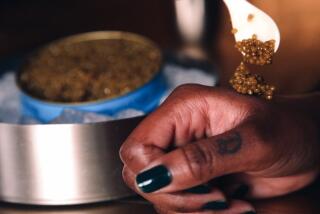Discoveries: ‘Milk,’ ‘Caviar,’ ‘Cake’
Caviar
A Global History
Nichola Fletcher
Milk
A Global History
Hannah Velten
Cake
A Global History
Nicola Humble
The Edible Series / Reaktion Books: $15.95 each
Each book in the “Edible Series” describes a food or drink — its history, how it has evolved and how it has figured in various cultures across civilization. Twenty-eight of these little butter-cream-colored gems are in the works; 11 so far have been published. Printed on heavy, rich stock with drawings and color photos, they are an appetizing bunch.
This new group has a particular appeal; most readers could survive quite nicely on cake and milk and caviar. While milk and caviar have their hazards, no species must die in the making of cake; it has no special bacteria, no infant-killing properties. Here’s where a little knowledge is a dangerous thing — sturgeon, that primitive, long-lived fish from which the world’s most coveted food has come for centuries, is endangered.
Nichola Fletcher takes us back to the first dinner, in 1240, for Bhutu Khan, grandson of Genghis, at which caviar was served in abundance. She introduces us to the Armenian, Russian and French families whose names have been synonymous with fine caviar. We read John Smith’s account of the bountiful sturgeon in his letters home, written in 1607. We travel back and forth across the Caspian Sea in search of “ikra,” the humble Russian word for fish roe.
Hannah Velten explores the history of milk with its image of purity, its dangers as bacteria-ridden poison. In the 1900s in New York, she writes, scores of infants were killed by contaminated milk — mothers were persuaded by clever marketing campaigns not to breastfeed. Milk, like wine, has its terroir — the bitterness or sweetness of the herbage fed to cattle is easily tasted. The first evidence of milking comes earlier than historians had thought — in the 7th century BC in Turkey. Velten describes the “trickery” used in various countries to convince animals to give up their milk. She writes about how cultures around the world address issues of spoilage and about the foods made from milk that spread its nutrients across a year — kefir, cheese, butter and yogurt. She takes a quick spin through the issues surrounding pasteurization and the recent increase in demand for raw milk (in Australia, producers filling demand illegally for raw milk label their product “Bath Milk”). A recipe for Cleopatra’s milk and honey bath for smoother skin is included in the back.
As for cake, well, it’s all joy, although the sweet, spongy stuff we know and love does not appear on the scene until the mid-18th century. The first cakes, writes Nicola Humble, were disc-shaped, flattened rounds of whole grains, maybe with some dried fruits, cooked on flat rocks in the ashes of a fire. They were often used as religious offerings or served at celebratory events. Oat cakes and medieval gingerbread were common in Great Britain. Then came the bread buns, the sweet breads and the coffee cakes. Icing appeared in the form of egg whites and rose water sometime in the 17th century.
Humble introduces some of the first French bakers, such as Antonin Carême. In America, baking cakes evoked home, Mom and family celebrations. Humble takes a quick spin through literature: Proust, Dickens, Flaubert, Colette, Lewis Carroll and others all extolled the virtues and profound meanings of cake. Each country has its nostalgic cake: Humble describes the Twelfth Cake in England, the Moon Cake in China, Australia’s Lamington cakes. There is the postmodern cake movement, begun in the 1990s and the rebirth of the iconic cupcake. Cake is “as much an idea as a reality,” she writes. “Representing kitsch and nostalgia, femininity and childhood, manufacture and home craft, tradition and innovation.” Recipes for ancient, classic and unusual cakes are included.
Salter Reynolds is a writer living in Los Angeles.
More to Read
The biggest entertainment stories
Get our big stories about Hollywood, film, television, music, arts, culture and more right in your inbox as soon as they publish.
You may occasionally receive promotional content from the Los Angeles Times.










